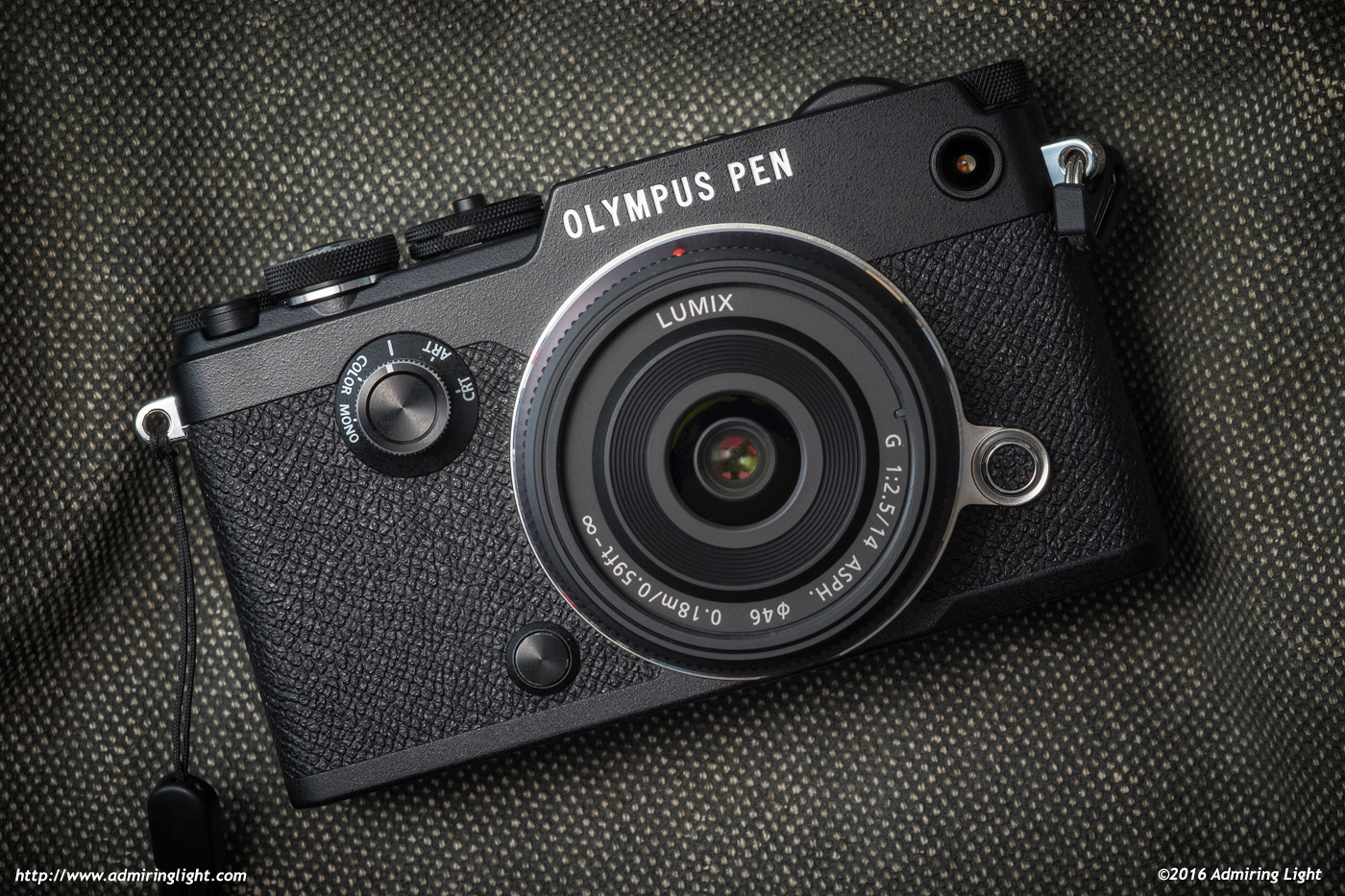Contents
Image Quality
The Pen-F is the first Olympus camera to have an upgraded 20 megapixels image sensor, and follows the Panasonic GX8 as the second Micro 4/3 camera at that resolution. Let’s see how it performs.
Dynamic Range and Color
While the sensor in the Pen-F is ‘all new’, I can’t say I see much difference with regards to dynamic range and color. The dynamic range is still very good, and competitive with many APS-C sensors on the market, but falling short of the most recent APS-C efforts. This is most visible as a bit of a harsher transition of tones in the highlights and deep shadows. This sounds bad, but it’s a very subtle difference to be honest. Despite trailing some of the competition in the mirrorless space, the Pen-F’s dynamic range is still good enough to provide a wide range of tones that will capture the majority of scenes in a single capture. The Pen-F, like most Olympus cameras, tends to gear their RAW files towards underexposure, so you’ll likely have a fair bit of highlight headroom to recover in your RAW files, while shadows tend to get noisy a bit faster than larger sensors. Still, the performance here is similar to the later 16 megapixel sensors used by Olympus, which should be plenty for most photographers.

Color response is typical Olympus, which is excellent. Olympus manages excellent tonality and color in the JPEG files, and the RAW files react very well to color adjustments. The resulting images are natural, but with some vibrance, which I find very pleasing.
Detail and Noise
The Pen-F’s big advantage over earlier Olympus cameras is in the extra detail the 20 Megapixel sensor can provide. The move from 16 megapixels to 20 is a modest one, but the Pen-F seems to make the most of this move. I felt that the improvement in resolution felt more than you’d expect from the move to 20 megapixels, and I can’t really explain why. Perhaps it’s the slight increase in detail combined with Olympus’ excellent contrast curves, but I felt the detail popped quite a bit with this camera. You’re not going to be able to print appreciably larger due to the 4 megapixel increase, but I think you’ll see a small, but visible difference in prints at 12×18″ and larger.
With an increase in pixel density, there’s often an increase in noise, and thankfully, the Pen-F avoids this pitfall. Per-pixel noise seems very similar to earlier MIcro 4/3 cameras at lower ISOs and a slight improvement at 100% at higher ISOs, but since each pixel makes up a smaller part of the image, the overall noise level in the image is definitely lower. The change isn’t huge, but it gives a bit of extra breathing room at the high end, and I’d put the advantage of the Pen-F somewhere around a half a stop over something like the E-M5 Mark II. The Pen-F looks good to ISO 1600, while ISO 3200 images are perfectly usable when exposed correctly. ISO 6400 gets a bit noisy, but with proper noise reduction can still produce good prints and excellent web reductions. ISO 12,800 gets into the realm of web use and small images only. I’d avoid 25,600 altogether.

JPEG Quality
There’s been no change with regards to the Olympus JPEGs. The camera still produces extremely high quality JPEG images that are among the best in the industry. Images are saved with minimal compression, have nice natural colors and contrast. There is a bit too much smoothing in the noise reduction algorithm when set to default, but adjusting that setting down helps improve the results quite a bit. Once noise reduction is lowered, JPEGs yield a fair bit more detail and, in my opinion, a more natural looking file that is truly excellent.
Video
As I note at the beginning of each review, I’m not a videographer, so for a true look at the video features, I’d look to other review sites. The Pen-F can shoot 1080p video at 60, 30 and 24 frames per second (though getting to 24p is a bit tricky at first). There’s no microphone input, so serious video shooters will want to look elsewhere. One thing most everyone can enjoy, though, is the excellent IBIS system when shooting in video mode, which creates very stable handheld movies.


A very informative and honest review. Do you recall if the EV dial is active, when in Manual mode and auto ISO? On the GX8, with such settings, it gets turned off. Such a waste.
Finally a comprehensive and thorough reviewer who advises us that “your money is more wisely spent elsewhere.” As a satisfied owner of the E-M10 II I couldn’t agree more. To me, a camera that doesn’t offer comfortable haptics and ergonomics is a “no sale” no matter how nice is the rest of the package. There will just be no joy in using it. As for the price, the less said the better. Thank you for an excellent analysis. Respect.
A very good review, as always. But in your conclusion you miss one – or, rather, *the* – crucial point: The Pen-F gives some “rangefinder feeling”, which no other Olympus does. Whether this is worth the price is a question which everybody must answer for him/herself.
No, I address it. The last paragraph. It really is the lack of a viewfinder hump. That’s it. It’s no smaller than the OM-D series cameras with the exception of the hump. I don’t feel the camera gives any more of a rangefinder feeling than any other Mirrorless camera. The only Mirrorless camera that comes close is the Fuji X Pro series, with the optical finder and frame lines. This just lacks a hump.
It’s rangefinder styled, but it doesn’t have a rangefinder feel.
With “rangefinder feeling” I didn’t mean the lack of the bulb, but rather that the camera doesn’t hide your face while photographing. It may be a minor point, but for me it allows for a completely different communication when photographing people. I agree that it’s not the same as a true rangefinder, of course.
Correction: I meant to write “hump”, not “bulb”, of course.
Hahah, my Koni Omega Rapid 200 is a real rangefinder (with a cinema-scale viewfinder to go with it), and definitely hides my face. It also weighs 2 kg, though. For me the rangefinder aspect is the super-precise feel of manual focussing with the rangefinder patch. With a well-calibrated lens, I feel like it’s possible to manually focus more quickly and accurately than any other system (better than any SLR OVF, better than focus peaking, and similar to magnified view but with the whole perspective). As Jordan says, I feel like the X-Pro 2 only gives part of that feeling, since the OVF is not usable for manual focussing in a conventional sense.
thank for a very nice review , a great camera imho but imperfect ….id love to see an article about the best settings and why in the overly complex dense menus …..i still cant figure out how to lock the focus point in the center of the grid when using legacy lenses and also how to turn off the lcd screen
ive got the pen F in silver and am enjoying using the .64 x version on the metabones speedbooster and nikon glass
like fast nifty fifties and wiser primes like the 24mm,2.8 and 35mm 2 AND just picked up the wide body cap lens
also the 12 -32 on the pen is a great combo
A little disappointed by the pictures. Pen-F deserves another target that the poor Panasonic 14mm. It would be best suited to the Panasonic Leica 15mm
So you’re upset I didn’t go buy a $550 lens, so that when I took pictures of a camera, it looked better? Feel free to donate that money to the site, and I’ll gladly purchase one for product shots in future reviews.
LOL!
I think his example picture is more than “good enough”, especially the “Under the Railroad”, golden hours, flowers…
I’ve always enjoyed reading the reviews here, always on point with great detail. The sample images are really good too!
The “walking after the rain” is really good! Would’ve liked to see it in B&W. Still, very good composition.
In the Focus Bracketing mode, I do not get a single stacked image. I get the 5 images but not a 6th one with them all stacked. Is there no in camera stacking in the PenF? TY
Jordan,
Excellent article. I, however, disagree with your final statement that my money would be better spent elsewhere. I traded in my OMD EM5MII for the PEN-F and I have not regretted my decision. The EM5MII was (and is) an excellent camera, and certainly produces fantastic images, but I needed just that little bit “extra” with the 20mp vs the 16mp. Yes, I’d love to have the weather-sealing, but it’s not a show stopper for me if the camera doesn’t have it. Sure I would’ve preferred paying $200 less…but after spending the money, I find the results I’m getting more than justifies the cost (but of course, “your mileage may vary”).
Is it perfect? No, there is no such camera. But when I’m out and about, it’s the first camera I grab and it’s with me on a daily basis. My biggest complaint is more with M43 cameras’ in general: their low-light capability lacks when compared to a capable DSLR (such as the Nikon D750, which I also shoot). So for now…as long as the light is good (dawn to dusk, really) I am assured of capturing great images at a very good frame rate. For the record, I find the best feature to be the silent shutter.
One more thing: in my experience, the PEN-F raws are a bit more malleable than the comparable EM5MII raws. It may very well be due to the slightly greater detail resolution (20mp vs 16mp), but the new(er) sensor may also have a lot to do with it. What I’m finding is that I can shoot at or below optimal exposure and still pull out the shadows without an alarming increase in noise. I couldn’t do this with the EM5MII raws (since I shoot a great deal with the D750, the Nikon raws are almost “rubbery” in the amount of post-process manipulation that can be applied without any degradation…and that is the standard I use to compare the PEN-F raws).
Excellent review, nonetheless. Thank you.
Frank Villafane
Urban Industrial Imaging
You can view my mirrorless gallery at the link below:
https://www.500px.com/urbanindustrialimaging/galleries/sin-espejo-mirrorless
Thanks for a very thorough review. I agree, a little overpriced at $1,199 for the body only.
Hi Jordan, just across this review as I am toying with the idea of getting the pen-f. Does the compact panasonic zoom work well with olympus cameras? Did you have to apply the lens profile in lightroom?
Or I might just get GX800 with that compact zoom kit. 🙂
Thanks
Good review but I find the conclusion harsh. All these cameras , as long as they produce good pictures , fulfill a need. Pen F does not have a big grip because it is not to be used with long and heavier lens, there is the OMD for that. It is used as a discreet everyday camera. Most of the pictures which have changed the world come from this type of camera. The absemce of a grip make them easy to put in a pocket and to be there when needed.
I think my conclusion is more than fair. Sure it will fill a need for many people, and I say so in my review and in the conclusion, but it is hard to recommend due to the price, and that is still true today. The Pen F is 3 years old and still $999. That’s an absurd price given the competition. A Sony a6400 has better AF, a better EVF, a better sensor, is more comfortable to hold and shoot with, costs $100 less, and in a practical sense, is about the same size too.
You can get a Fuji X-T30 for less money, and it is better in nearly every way.
Olympus priced this camera at the time almost as if m4/3 was still the only player in the mirrorless world. That reality is gone now. The full frame Canon EOS RP is only $300 more expensive, and only $200 more than the Pen F was at launch.
All that said, it’s still a very nice camera, and it may well be exactly what you are looking for. And that’s great. But it’s still overpriced.
Jordan – I’m STILL shooting a trio of 7yo EM5’s with my 12mm f/2, 17mm f/1.8, 45mm f/1.8 & 75mm f/1.8 lenses and TBH, I’m not happy with the images I’m getting even though I’ve been shooting Olympus for 3 years after having shot Canon Film and DSLR’s since 1989.
One of my friends/colleagues is an Olympus Visionary and I made the switch per his recommendation. As a documentary shooter, one of my biggest needs is shooting in marginal lighting conditions (ISO1600-3200) and getting as much IQ as possible. I’ve been investigating whether to stick with Olympus by going the Pen-f route or moving completely to Fuji X-E2/3’s or possibly X-Pro 1/2’s with their fast primes. Or do I look at Olympus Pro primes? The biggest limitations I’m really seeing is less dynamic range and alot of noise at higher ISO’s with the m43 platform. Fuji seems to have done things right but I’m still not totally convinced. The EM1 series I have no interest in due to its size. And the ergonomics of the EM bodies is still as unintuitive now as it was when I made the switch and that has gotten in the way on more than one occasion for me causing me to miss those decisive moments – Very Frustrating.
I’m totally confused which way to go. I typically shoot RAW only but from what I’ve read, in camera Fuji jpgs cant be matched. Any thoughts? If too much to answer you can email me directly – I’d really appreciate it.
Fuji has its own quirks, but I think there is a nice bump in image quality moving to Fuji. Fuji controls are really a personal thing. I love them, and find them to be incredibly intuitive and easy to use. Others do not, so that’ll be up to you. You will definitely see an improvement in noise control with Fuji compared to m4/3. I will say that ergonomically, the X-E and X-Pro series are lacking in the grip department, but controls are very good. The X-T2/X-T3 is a lot more comfortable to hold, in my opinion.
I love my PEN -F. Easy to carry and people like it . With the 17mm or 45mm Oly it’s Just there when I need it on my hikes.